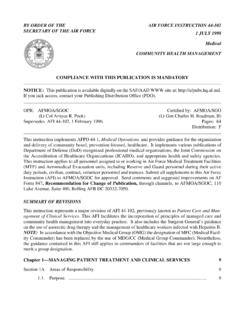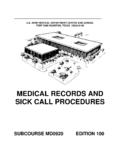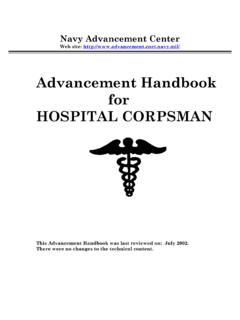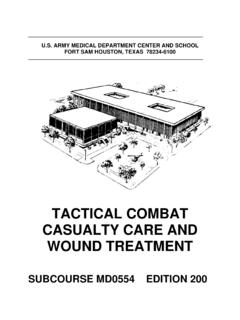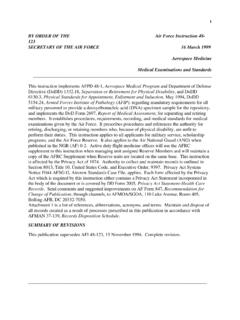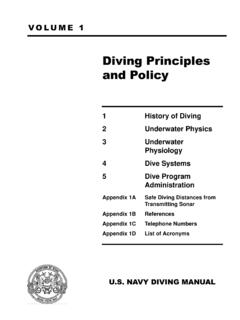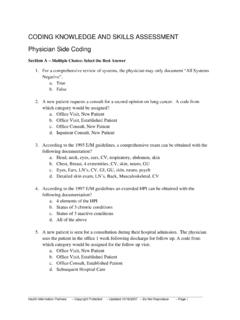Transcription of Hospital Corpsman Sickcall Screeners Handbook
1 Hospital Corpsman Sickcall Screeners Handbook BUMEDINST 6550:9A Naval Hospital Great Lakes April, 1999 This Edition Produced by the Brookside Associates Ltd Medical Education Division 542 Lincoln Avenue Winnetka IL 60093 C. 2006, Brookside Associates Ltd. All rights Reserved. Page 1 of 215 Page 2 of 215 Hospital Corpsman Sickcall Screeners Handbook BUMEDINST 6550:9A Contents 2 Course Utilization of Military Sick Call SOAP The Ear, Nose, and Respiratory The Heart and Blood Neurologic Gastrointestinal Genitourinary Sexually Transmitted Endocrine Pharmacology - Medical Lesson Training Guides (LTGs).
2 84 Examination of the Abdominal Cardiovascular Disorder and Exam Dermatology Disorders and GI, GU, STD HEENT Disorders and Your Command: Student Handout, Male Examination of the Musculoskeletal Mental Status and Neurological Your Command: Student Handout, SOAP Taking a Medical Thorax, Lungs, and Respiratory Hospital Corpsman Sickcall Screeners Handbook Introduction "Desert Storm" demonstrated once again that Navy Hospital Corpsmen are vital members of the Health Care Delivery Team. Their responsibilities and roles are expanding as are the demands placed on them to provide quality health care.
3 In order to meet these demands and better prepare Hospital Corpsmen, training is a necessity. The Sick Call Screeners Course is such a program and is directed at the junior Hospital Corpsmen (E-2 to E-4). Here the Corpsmen are exposed to clinical subjects taught by a staff of highly skilled personnel (Physicians, Nurses, Physician Assistants, and Independent Duty Corpsmen). The goals and objectives of this course are: 1. To give the Corpsmen a better understanding of the clinical aspects of medicine in a Military Sick Call setting. 2.
4 To expose corpsmen to the techniques of obtaining a history, performing a physical exam and recording their findings in an outpatient record. 3. To learn the signs, symptoms and therapy for medical problems that are common to military Sickcall . Page 3 of 215 Hospital Corpsman Sickcall Screeners Handbook Course Description The Military Sick Call Screeners Course is divided into modules that cover specific areas of medicine. The topics include: Dermatology, Eye, ENT, Neurology, Cardiology, Pulmonary, Gastrointestinal, Orthopedics, Sexually Transmitted Diseases, Infectious Diseases, Endocrinology, and Pharmacology.
5 Each module contains sections on anatomy and physical examination and a number of common medical problems presented in a SOAP format. The course is designed to be presented over a period of eighty hours. Written test and quizzes, a mid-term and a comprehensive final exam will be given. A practical examination will also be used to evaluate the student s ability to perform a physical examination. Instructors will draw upon personal knowledge and experience and demonstrate the physical examination techniques required for each section. Page 4 of 215 Hospital Corpsman Sickcall Screeners Handbook Utilization of Military Sick Call Screeners Policy and guidance for the Military Sick Call Screener Program is contained in BUMEDINST The primary goal of the Military Sick Call Screener Program is to provide timely, quality care for active duty personnel with minor medical conditions.
6 Screeners are not to function as independent providers. They must work under the direct supervision of a medical officer who is responsible for the care they provide. The following guidelines must be followed: 1. The SOAP format must be used when evaluating a patient. This will include the history, physical examination, assessment, and treatment. 2. The Military Sick Call Screener will consult with the supervising medical officer prior to the patient leaving the treatment facility. Military Sick Call Screeners will have 100% of their records reviewed by the supervising medical officer and countersigned.
7 3. A screener may order a CBC and urinalysis. Any other studies must be ordered by the supervising MO/PA/IDC. 4. Screeners must realize their limitations and immediately refer to an MO/PA/IDC any patient with one of the following conditions: a. Febrile illness with temp. exceeding 101 F. b. Acute distress such as, breathing difficulties, chest pain, acute abdominal pain, suspected fractures, lacerations, etc. c. Altered mental states d. Unexplained pulse above 120 per minute e. Unexplained respiratory rate above 28 or less then 12 per minute f.
8 Diastolic blood pressure over 100 mm Hg If any uncertainty or doubt in the assessment of the patient's medical condition exists, refer to your medical officer. Also, if any patient presents with the same complaint twice in a single episode of care, he must be referred to a medical officer for evaluation and treatment. The only exception is patients returning for routine follow up of a resolving acute minor illness or injury. 5. All prescriptions written will be signed by the supervising MO/PA/IDC. Page 5 of 215 Hospital Corpsman Sickcall Screeners Handbook SOAP Note LTG # Allotted Lesson Time: References: Nursing Procedures Manual HM 3&2 Terminal Learning Objective: Given a simulated patient with a simulated complaint, the student will be able to obtain the needed information for proper treatment of the patient.
9 Enabling Learning Objective: Given a list of components of a SOAP note, select by shading the correct response. a. The information charted for each component. b. The proper way of obtaining the information for each component. Problem oriented medical record approach (POMR) The (E. R.) method is the only accepted method of medical record entries for the military. a. S: (subjective) - What the patient tells you. b. O: (objective) - Physical findings of the exam. c. A: (assessment) - Your interpretation of the patients condition. d. P: (plan) - Includes the following: 1.
10 Therapeutic treatment: includes use of meds, use of bandages, etc. 2. Additional diagnostic procedures: any test which still might be needed. e. E: (patient education) - special instructions, handouts, use of medications, side effects, etc. f. R: (return to clinic) - when and under what circumstances to return. Components of the SOAP note. 1. Medical History - Gives you an idea of the patients problem before you start physical exam. a. biographic data b. chief complaint 1. This is the reason for the patients visit. 2. Use direct quotes from patient.
